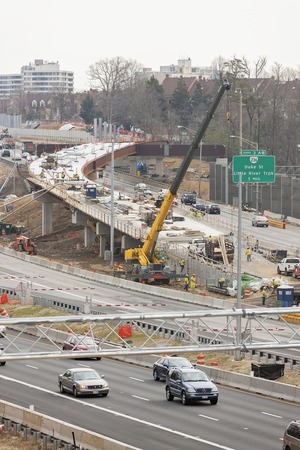

Contractors often get the rap of being tough guys, said Michael McNally, CEO of Skanska USA Inc., "but these are compassionate people who really care about the people they work with. If they see anyone get hurt or killed on a jobsite, it is devastating." McNally addressed leaders from about a third of the 31 companies that sponsored Safety Week. They gathered to kick off the program on May 5. "Our objective is for the entire industry to be part of this," he said.
The firms involved belong to either the Construction Industry Safety Initiative or the Incident and Injury Free Executive Forum—leadership groups committed to eliminating worker injury (ENR 3/17 p. 66). Said Robert Alger, CEO of Lane Construction, the idea for Safety Week came from wrestling with a question: "What can we do to make a bigger difference in the industry?" The 31 firms, representing $70 billion in revenue and one million workers, encouraged the whole industry to join them in sharing best practices and promoting safety.
They made the commitment very public through a full-page USA Today ad, stating: "It's work, not war. 90,000 hardworking men and women are injured on construction jobsites across the country every year. 775 are killed. That's why 31 construction firms are standing together for the first time to honor their own and eliminate worker injury. Because one is too many." McNally said the ad is meant "to raise the awareness of the tragedy of construction-worker injury ... and to let people know that we, as an industry, intend to address this issue as a team."
The kickoff was held at the $700- million, 29-mile 95 Express Lanes project in Springfield, Va., a P3 among Virginia Dept. of Transportation, the Federal Highway Administration and Fluor-Transurban. A tour highlighted measures the project is using to achieve results of 0.39 recordables against a goal of 0.4 (the national average is 3.6) and hit its lost-time goal of zero (the national average is 1.5). Walter J. Lewis III, project director for the Fluor-Lane design-build joint venture, said he focuses on "all the little things that can trip you up," such a hand injury or a trip-and-fall issue.
He added, "We definitely have a zero-incident culture," with a strong budget commitment for safety and ownership of safety at all levels. Lewis has to give a presentation to top executives if there is an accident. "I do not like giving those presentations," he says emphatically.
The job maintains a drug-free environment with testing, daily job reviews, job-specific safety training and incentives, such as handing out Dunkin' Donuts or Chipotle cards to crews working safety. "Chipotle cards were a big hit," he says. A driver-awareness program includes "orange cones, no phones" signage that has reduced distracted driving in the area, according to a 2014 report.
Companies put their own spin on the Safety Week roll out. Noting that 20% of employee injuries were eye injuries, Limbach CEO Charles Bacon said his firm gave out safety glasses and dedicated a day to eye safety, among other activities.
A. Ross Myers, CEO of American Infrastructure, said, "It's all about going home safely to your family, so we are having weekend activities for family members as part of our program."
Occupational Safety & Health Administration's Paul Bolon gave Safety Week a "wow," noting that he could see the firms' safety culture from top to bottom.







Post a comment to this article
Report Abusive Comment